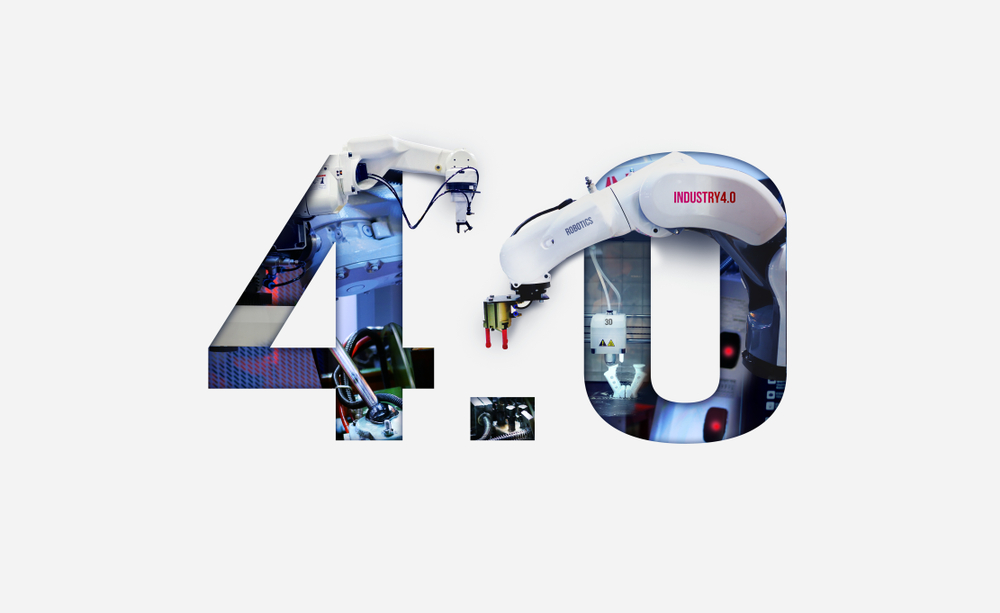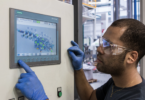Amid warnings of a global recession, energy price hikes and disrupted supply chains, many manufacturers are struggling to scale the use of Industry 4.0 technologies.
“It’s hard enough to digitize a single site. But then how do you scale from one site to many?”, asked Enno de Boer, Senior Partner, McKinsey & Company and Global Lead of its digital manufacturing work.“Especially small sites, all different from each other, with old equipment and old ways of working. That’s what keeps so many companies from digitizing successfully—they think it can’t be done at scale, so they don’t try. And they’re left vulnerable to the next big shock.”
But factories invited to join The World Economic Forum’s Global Lighthouse Network this week are proving that “transformation at scale is possible,” Francisco Betti, the Forum’s Head of Advanced Manufacturing and Value Chains, said during an October 13 webcast that he co-hosted with de Boer. These manufacturing sites are leveraging technologies such as artificial intelligence, 3D-printing and Big Data analytics to achieve “productivity, sustainability and resiliency all at the same time,” he said.
Amid warnings of a global recession, energy price hikes and disrupted supply chains, many manufacturers are struggling to scale the use of Industry 4.0 technologies.
“It’s hard enough to digitize a single site. But then how do you scale from one site to many?,” asked Enno de Boer, Senior Partner, McKinsey & Company and Global Lead of its digital manufacturing work, “Especially small sites, all different from each other, with old equipment and old ways of working. That’s what keeps so many companies from digitizing successfully—they think it can’t be done at scale, so they don’t try. And they’re left vulnerable to the next big shock.”
But factories invited to join The World Economic Forum’s Global Lighthouse Network this week are proving that “transformation at scale is possible,” Francisco Betti,the Forum’s Head of Advanced Manufacturing and Value Chains, said during an October 13 webcast that he co-hosted with de Boer. These manufacturing sites are leveraging technologies such as artificial intelligence, 3D-printing and Big Data analytics to achieve “productivity, sustainability and resiliency all at the same time,” said Betti.
The new lighthouses, run by companies such as Cipla, Danone and Sany Heavy Industry, are deploying large digital transformation programs at scale across 20 to 40 factories in parallel, with thousands of people involved, dedicated governance in place and deploying multiple innovative yet standardized technology use cases, over time spans of just 18 to 24 months.
The 11 new lighthouses include
- Agilent Technologies in Singapore: With the ambition to simplify high-tech manufacturing in low-volume, high-complexity instruments to meet rising customer demand, Agilent Singapore deployed Industrial Internet of Things-powered digital twin, AI and robotic automation technologies to achieve sustainable growth, overcoming bottlenecks from specialized manpower and transforming the workforce into scalable Industry 4.0-ready generalists. The company said ths resulted in an increased output by 80%, improved productivity by 60%, improved cycle time by 30% and quality cost by 20%.
- CATL in Yibin, China: In order to cope with significant business growth, and higher quality and sustainability expectations, CATL builds up a large greenfield in Yibin city. The plant further deployed AI, IoT and flexible automation in addition t lighthouse digital initiatives at its headquarters. The company said this helped them achieve 17% increased line speed, 14% reduced yield loss, and zero carbon emission.
- Cipla in Indore, India: To preserve access to high quality affordable drugs globally while facing an increase in material and labor costs, Cipla deployed digital, automation and analytics technologies to 22 Indian sites in parallel. Indore’s Oral Solid Dosage facility led this journey by implementing 30 Industry 4.0 use cases, moves it said improved total cost by 26% and enhancing quality by three times, while reducing greenhouse gas (GHG) emissions by 28%.
- Danone in Opole, Poland: To address an increasing product portfolio complexity, Danone Opole engaged its whole workforce in a digital transformation journey to deploy connected shopfloor, artificial intelligence and automation at scale. As a result, the company said it improved costs by 19%, efficiency by 12% while improving quality and reducing GHG emissions by close to 50%. The site became a transformation leader for the other 39 Danone plants in Europe and top employer in the local market.
- Dr. Reddy’s Laboratories in Hyderabad, India: Facing business challenges from severe price erosion and rapidly evolving quality expectations, the 25-year-old site embarked on large scale digitalization to sustain and grow in the generics pharma market. The site deployed more than 40 Industry 4.0 use cases by operating in “garage mode” and leveraging Industrial Internet of Things technology and a democratized platform for advanced analytics. As a result, the company said it improved manufacturing cost by 43% while proactively enhancing quality and reducing energy by 41%.
- Flex in Sorocaba, Brazil: To improve site competitiveness, sustainability and health, Flex implemented Industry $.0 initiatives along the end-to-end value chain, such as IoT-enabled recycling of electronic waste and supply chain control tower. It says its digital transformation journey resulted in a 50% labor cost improvement, an 81% material loss reduction, while increasing customer satisfaction by more than 18% and improving employees well-being.
- Haier in Qingdao, China: Facing growing demand for customized design, fast delivery and high quality, Haier refrigerator factory leveraged Big Data, digital twin and advanced visual inspection technology to accelerate R&D, upgrade manufacturing process and logistics scheduling mode. The company says order response lead time has been shortened by 35%, production efficiency has been increased by 35% and quality performance has been improved by 36%.
- Midea in Shunde, China: In order to meet demand for high quality products delivered in shorter lead times, Midea Shunde factory has deployed AI, digital twin and other Industry 4.0 technologies in the end-to-end value chain. The company sais this has helped them achieve 24% lower unit production cost, 41% shorter lead times, 30% shorter R&D lead time and 51% less defect rate.
- Mondelēz in Sri City, India: Driven by the aspiration to outgrow the market through superior volume delivery, cost leadership and building further resilience and diversity in a volatile environment, Mondelez’s Sri City deployed end to end digitalization, predictive analytics, artificial intelligence and advanced automations which the company said increases labor productivity by 89%, reduce manufacturing costs by 38% and sustain 50% female workforce. Thus, making it a benchmark manufacturing site for Mondelez globally.
- Sany Heavy Industry in Changsha, China: To address the challenges from industry specific market cycle fluctuations and product complexity, Sany Changsha leveraged flexible automation, AI and Industrial Internet of Things technologies at scale to build a digital and flexible heavy equipment manufacturing system. As a result, the company said the site expanded capacity by 123%, improved labor productivity by 98%, and reduced unit manufacturing cost by 29%.
- Western Digital in Shanghai, China: To address a 250% annual growth rate, short technology transition pace of 18 months and workforce challenges, Western Digital semiconductor backend factory in Shanghai implemented diverse Industry 4.0 use cases such as automated product design system, Machine Learning-based virtual wafer test and an intelligent planning system. The company said the site reduced time to market by 40%, product cost by 62% and improved productivity by 221%.
The latest cohort of lighthouses also includes four sites designated as Sustainability Lighthouses operated by Arçelik in Ulmi, Romania, Micron in Singapore, Unilever in Dapada, India, and Western Digital in Shanghai, China.
IN OTHER NEWS THIS WEEK:
FOOD
Israeli Startup Strikes Partnership To Boost 3D Printed Meat Sales In Europe
Israel’s Redefine Meat has struck a partnership with importer Giraudi Meats to drive European distribution of its “New Meat” steak cuts produced on 3D printers.The start-up, which raised $170 million in a series A financing round this year, operates large-scale meat printers at its Rehovot headquarters south of Tel Aviv, and a new factory in the Netherlands, hoping to establish its products as an alternative to conventionally produced meat.
AVIATION
Delta Invests In Electric Air Taxi Startup, Plans Last-Mile Airport Service
Delta Air Lines has invested $60 million in air taxi startup Joby Aviation, which is planning to build and operate an electric vertical takeoff and landing aircraft, or eVTOL, effectively an air taxi. The partnership that will initially offer passengers air taxi transport to and from airports in New York and Los Angeles.Delta will also have an exclusive five-year partnership with Joby operating eVTOLs as part of the Delta network. Delta CEO Ed Bastian envisions moving passengers to and from airports quicker and with less hassle.
MOBILITY
VW To Take 60% Stake in $2 Billion Tech JV With China’s Horizon Robotics
Volkswagen’s software unit Cariad will spend more than $2 billion and take a 60% stake in a new venture with Chinese technology firm Horizon. Together the companies will develop technology that can integrate numerous functions for autonomous driving onto a single chip that will be available only in China.The venture will mean Volkswagen has a supplier in each major region – North America, Europe and China – given its existing supply relationships with U.S. chipmaker Qualcomm and Franco-Italian STMicroelectronics.In contrast to the partnership with Qualcomm, Volkswagen’s software unit Cariad will play an active role in developing the chip technology with Horizon Robotics, and the know-how will be shared across the Volkswagen Group, the carmaker’s China chief Ralf Brandstaetter told Reuters.
Starbucks Wants To Become The Gas Station Of The Future For EVs
By 2030, there could be 26 million electric cars in the U.S., meaning there will be a need for more than 10 times as many EV chargers. Starbucks, with its 15,000 locations across the country, thinks that it could help fill part of the gap.I n a pilot this year, the company is partnering with Volvo and Chargepoint to install EV chargers in its parking lots along a 1,350-mile route from Denver to Seattle, with stops available roughly every 100 miles.
FINANCIAL SERVICES
America’s Oldest Bank To Safeguard Digital Assets Alongside Traditional Investments
BYN Mellon, America’s oldest bank said it would begin receiving clients’ cryptocurrencies on October11, becoming the first large U.S. bank to safeguard digital assets alongside traditional investments on the same platform. BNY Mellon won the approval of New York’s financial regulator earlier this fall to begin receiving select customers’ bitcoin and ether starting this week. The bank will store the keys required to access and transfer those assets, and provide the same bookkeeping services on those digital currencies that it offers to fund managers for their portfolios of stocks, bonds, commodities and other assets. The move marks an important milestone for traditional banks and their growing acceptance of digital assets as a legitimate market and a source of new business. While many Wall Street executives still question crypto’s potential and aim to tread cautiously until Washington clarifies how the market will be regulated, firms have responded to calls from a growing number of large investment-firm clients to step into their traditional role as intermediaries.
COMPUTING + BIOLOGY
Brain Cells In A Dish Played Video Game Pong, Researchers Say
In a paper published Wednesday in the journal Neuron, researchers claim they were able to demonstrate “the neurons could adapt activity to a changing environment, in a goal-oriented way, in real time.” “From worms to flies to humans, neurons are the starting block for generalized intelligence,” first author Brett Kagan, chief scientific officer at Cortical Labs in Melbourne, Australia, said in a statement. “So, the question was, can we interact with neurons in a way to harness that inherent intelligence?” Kagan said the team chose Pong due to its simplicity and familiarity, adding that it was one of the first games used in machine learning. His team is now testing other games. Kagan told CNN that in the short term, the technology could be used for “better drug discovery, disease modeling, and understanding how intelligence arises – which in turn could be used to develop new algorithms for machine learning.” To learn more about the potential impact of this discovery on business read The Innovator’s recent in-depth article.
To access more of The Innovator’s news in context articles click here.




